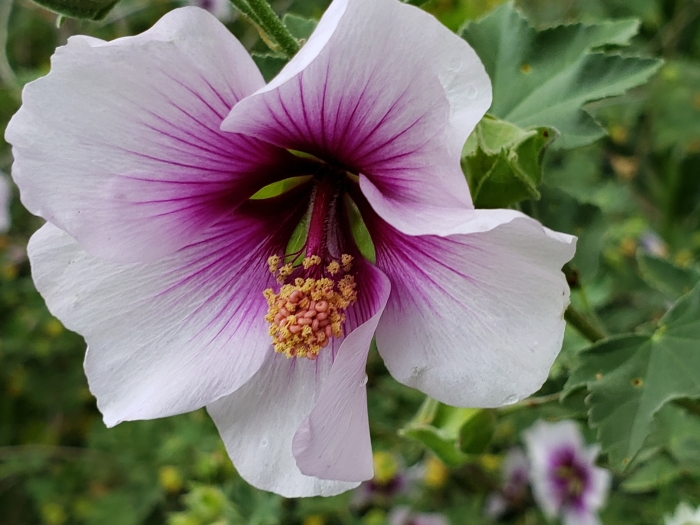Tree Mallow
(Malva subovata)
Tree Mallow (Malva subovata)
/
/

© Mary K. Hanson
CC BY 4.0
Image By:
© Mary K. Hanson
Recorded By:
Copyright:
CC BY 4.0
Copyright Notice:
Photo by: © Mary K. Hanson | License Type: CC BY 4.0 | License URL: http://creativecommons.org/licenses/by/4.0/ | Uploader: simpylmare55 | Publisher: iNaturalist |


























































Estimated Native Range
Summary
Malva subovata, commonly known as Tree Mallow, is an evergreen shrub native to coastal regions of the Western Mediterranean, particularly on cliffs and in rocky areas. It typically grows to a height and width of 6-8 feet (1.8-2.4 meters), presenting a rounded and bushy form. The leaves are rounded and lobed, with a soft, velvety texture. Tree Mallow produces showy pink and purple flowers from summer to fall, which are attractive to pollinators. The bark is generally smooth and light brown, and while not particularly notable, it provides a pleasant backdrop to the foliage and flowers.
Tree Mallow is valued for its drought tolerance and ability to thrive in coastal conditions, making it suitable for seaside gardens. It has gained the Royal Horticultural Society’s Award of Garden Merit, indicating its exceptional performance in cultivation. Common uses include ornamental plantings, borders, and as a focal point in Mediterranean-style gardens. It requires full sun to flourish and prefers well-drained soils. While it tolerates low water conditions, moderate watering will encourage more vigorous growth and flowering. It is generally free from serious pests and diseases, but may occasionally suffer from rust or fungal leaf spots. Pruning can be done to maintain shape and promote denser growth.CC BY-SA 4.0
Tree Mallow is valued for its drought tolerance and ability to thrive in coastal conditions, making it suitable for seaside gardens. It has gained the Royal Horticultural Society’s Award of Garden Merit, indicating its exceptional performance in cultivation. Common uses include ornamental plantings, borders, and as a focal point in Mediterranean-style gardens. It requires full sun to flourish and prefers well-drained soils. While it tolerates low water conditions, moderate watering will encourage more vigorous growth and flowering. It is generally free from serious pests and diseases, but may occasionally suffer from rust or fungal leaf spots. Pruning can be done to maintain shape and promote denser growth.CC BY-SA 4.0
Plant Description
- Plant Type: Shrub
- Height: 6-8 feet
- Width: 6-8 feet
- Growth Rate: Rapid
- Flower Color: Cream, Pink, Purple
- Flowering Season: Fall, Summer
- Leaf Retention: Evergreen
Growth Requirements
- Sun: Full Sun
- Water: Low, Medium
- Drainage: Medium, Fast
Common Uses
Bee Garden, Bird Garden, Butterfly Garden, Deer Resistant, Drought Tolerant, Hummingbird Garden, Low Maintenance, Rabbit Resistant, Showy Flowers
Natural Habitat
Coastal cliffs and rocky areas of the Western Mediterranean
Other Names
Common Names:
Scientific Names: , Lavatera maritima, Lavatera bicolor, Malva subovata, Malva wigandii, Malva subovata subsp. bicolor, Lavatera maritima subsp. maritima, Lavatera maritima var. purpurea, Lavatera subovata, Lavatera africana
GBIF Accepted Name: Malva subovata (DC.) Molero & J.M.Monts.